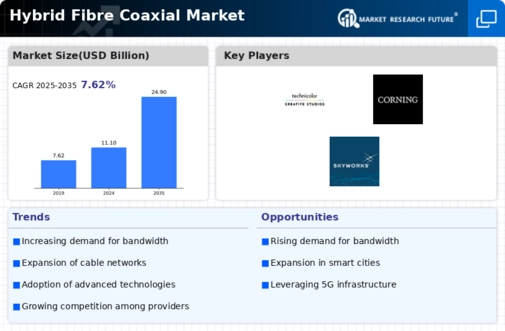Hybrid Fibre Coaxial Market Summary
As per Market Research Future Analysis, the Global Hybrid Fibre Coaxial Market was valued at USD 11.11 billion in 2024 and is projected to reach USD 24.92 billion by 2035, growing at a CAGR of 7.62% from 2025 to 2035. The market is driven by the increasing demand for high bandwidth internet, the rise of the Internet of Things (IoT), and the cost efficiency of HFC cables. The adoption of DOCSIS 3.1 technology is expected to enhance service delivery, while the automotive sector's integration of hybrid fiber-coaxial cables for smart vehicles further boosts market growth. Major players are focusing on R&D and strategic partnerships to expand their market presence.
Key Market Trends & Highlights
The Hybrid Fibre Coaxial Market is witnessing significant growth due to various technological advancements and increasing demand for connectivity.
- Market Size in 2024: USD 11.11 billion; Projected Market Size by 2035: USD 24.92 billion.
- CAGR from 2025 to 2035: 7.62%; Driven by high bandwidth demand and IoT trends.
- DOCSIS 3.1 is the fastest-growing technology segment; expected to enhance service capacity and speed.
- Asia-Pacific dominates the market; driven by cost efficiency and growing internet connectivity.
Market Size & Forecast
| 2024 Market Size | USD 11.11 billion |
| 2035 Market Size | USD 24.92 billion |
| CAGR (2024-2035) | 7.62% |
Major Players
Key players include Huawei Technologies Co Ltd, Nokia Networks, Cisco System Inc, Technicolor SA, Corning Incorporated, ZTE Corporation, and ARRIS International plc.













Leave a Comment